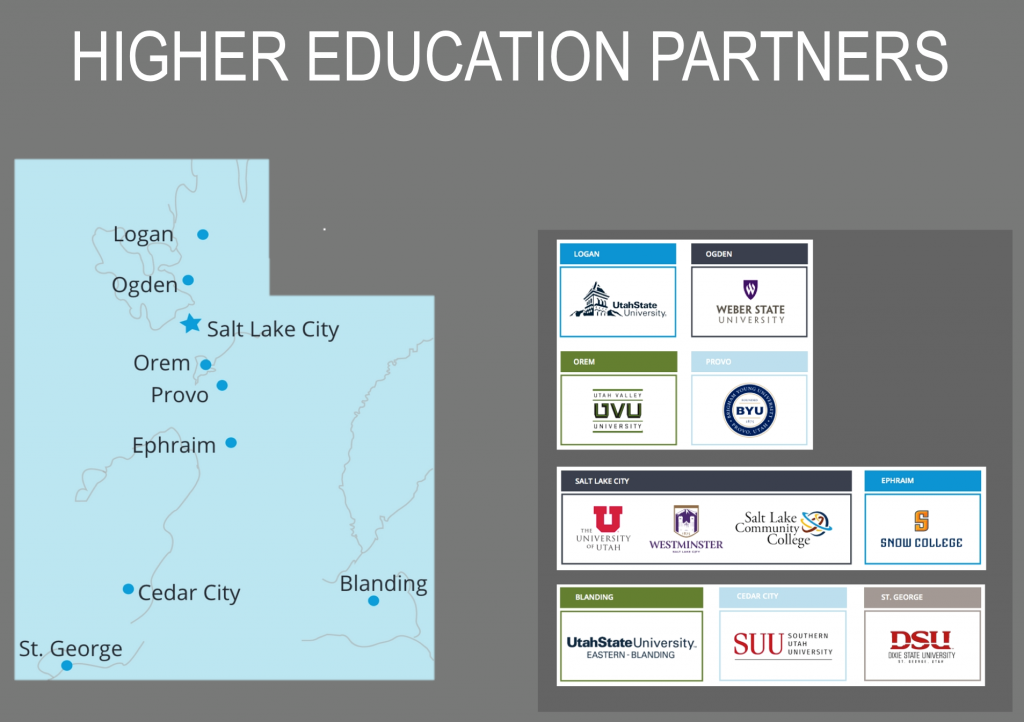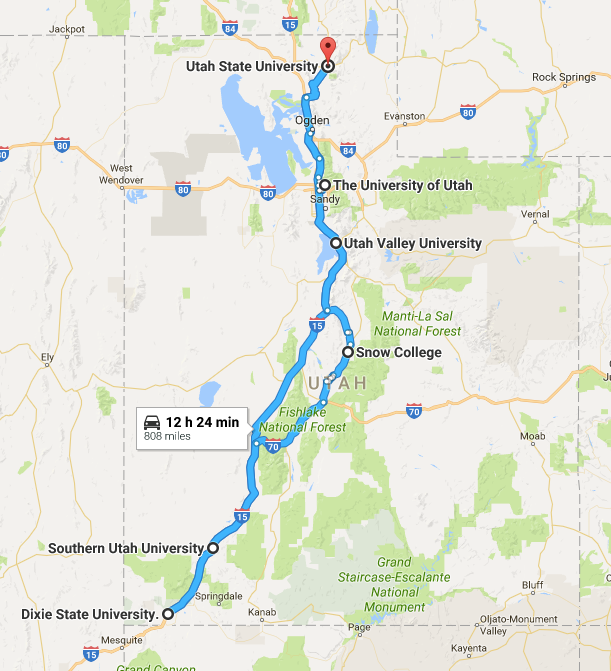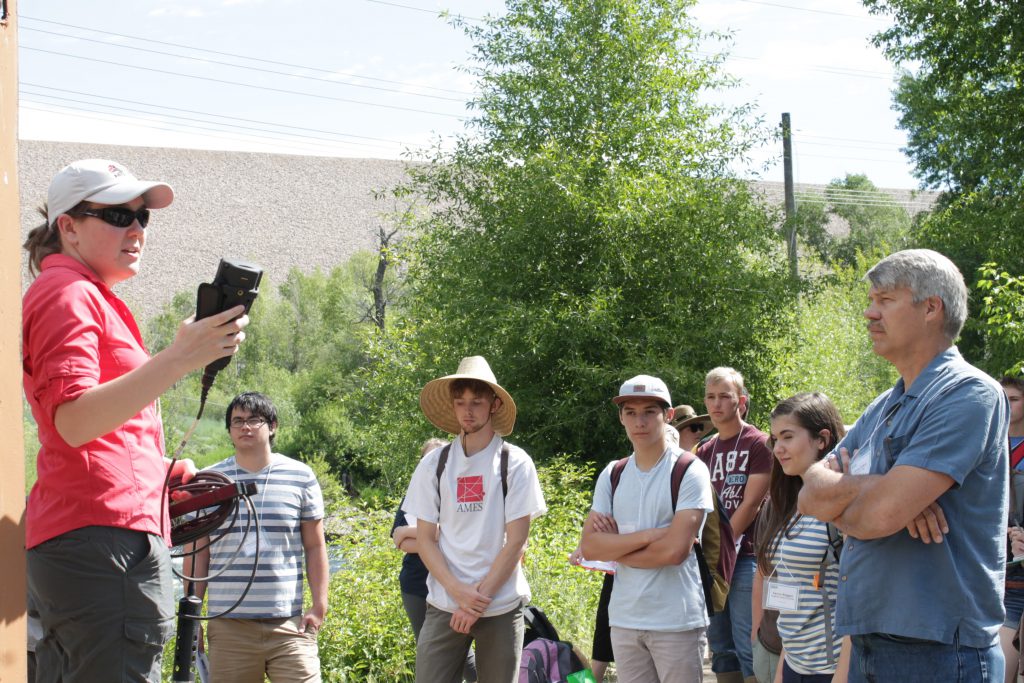We’re continuing to share reflections from the 2017 Community Engagement Fellows on the blog. In today’s post, Andy Leidolf introduces his four part series, “The Community Manager’s Survival Guide: Building Social Capital in Large, Heterogeneous, Geographically Dispersed Research Networks.” You can catch up on all posts by the Fellows here.
Posted by Andy Leidolf, Coordinator, Honors Program, Utah State University, and Executive Director, Society for Freshwater Science. Leidolf served as iUTAH Assistant Director and Project Administrator from 2014-2018.
iUTAH—A Textbook Case for Institutional Diversity
Like most other states, Utah has a large number of institutions of higher learning: in addition to three research universities granting doctoral degrees, there are eight primarily undergraduate-serving institutions (PUIs), both 2- and 4-year. Although Utah is generally perceived as a fairly homogeneous state, there is a surprising amount of diversity even among peer institutions.
For example, our research universities include both public and private universities (Brigham Young University is owned by the Church of Jesus Christ of Latter Day Saints, aka. the LDS or Mormon Church) and are situated in settings that span the rural-suburban-urban gradient. Not unexpectedly, these universities attract very different student and faculty populations.

Among PUIs, differences in student demographics are even more pronounced. Utah State University Eastern—Blanding, nominally and structurally a satellite campus of Utah State University, serves a student population drawn largely from the nearby Navajo Nation, with a student body that is 60% Native American. Weber State University, on the other hand, primarily serves a commuter population that includes a large percentage of Latinx and Hispanic students.
Subtle differences, such as the average age of students, exist among peer institutions like Dixie State and Southern Utah Universities and often go unnoticed and underappreciated. Yet, the percentage of traditional, college-age students vs. non-traditional, older students or returning adults can make a difference whether students at a particular institution are able and motivated to participate in statewide research or education opportunities.
From a strategic perspective, it is important to consider these differences when designing and implementing programs. But it is also important to acknowledge that these differences can give rise to widely divergent institutional cultures—as well as real or perceived status and power imbalances—that have the potential to breed conflict and impede collaboration. The iUTAH experience represents a textbook case of such a complex and diverse ecosystem of participating institutions.
The Motorcycle Diaries—Lessons Learned on a Road Trip Across Utah1
1 Disclaimer: I have not driven a motorcycle since high school. The road trip referenced here took place in the comfort of an—admittedly sporty—Mercedes CLA 250 that—having wheels and a motor—technically qualifies as a motorcycle.
Much of how I think about building social capital in scientific research collaborations is based on a road trip I took in my first year as Assistant Director of iUTAH. This was, first and foremost, a recruiting and engagement exercise. Expanding the reach of our research, training, and education programs. Bringing in new collaborators. Advertising opportunities. And it paid off: 808 miles later, for a comparatively modest investment of $3,071.52 in mileage, lodging, per diem, and three days’ worth of two 1.0 FTE staff’ members’ time, we felt that we had achieved some significant outcomes:
- 4 PUIs visited
- 2 new institutions engaged
- 20 faculty members engaged
- 4 new active participants recruited
- 1 invited seminar given
- 60 undergraduate students contacted
- 2 new connections with institutional Sponsored Programs Office staff made
But in addition to these concrete achievements, we also gained a new understanding and appreciation of the institutional culture of the PUIs we visited. By engaging with and listening to members of these communities face-to-face, we were able to make changes to some our statewide programs that made them more compatible with and attractive to a wider range of student demographics as represented by these very different institutions. Replacing our previous “one size fits all” approach to PUIs with targeted, individualized approaches to one-on-one engagement, and a more encompassing strategy to designing our statewide programs, allowed us to greatly increase the institutional reach of iUTAH over the course of the next few years and re-energized engagement with individual participants.
Most importantly, the gesture of senior project personnel visiting personally with participating institutions in even the farthest corner of our state did not go unnoticed. For faculty and students at these remote campuses, this was very much an issue of equity and fairness. Our being there, taking the time to get to know them and their culture, and participating—if only for a day or two—in activities with them, was an acknowledgment and validation of their role in and contributions to our project, and further emphasized the fact that in iUTAH, we were all equal partners.

Navigating the R1-PUI Power Imbalance
As a former PUI faculty member myself, I can appreciate the unique challenges faced by PUI faculty, particularly when it comes to being able to conduct research, one of the central missions of the iUTAH project. This is not to say that PUI faculty have it harder, just that their challenges are different: capacity, resources, time.
Whereas R1 universities are flush in the former two, and allow—demand, really!—faculty to invest a large proportion of the latter into research, PUI faculty frequently have little to no resources to support research, and invest almost all their time into satisfying a teaching load that can average 12 credit hours per semester or more. Depending on their background and experience, they may have little training in how to develop a research program, particularly one that relies heavily on undergraduate students.
Working successfully to advance and diversify our state’s research enterprise by leveraging the talent, passion, and energy of PUI faculty required becoming not just a resource, but a champion for them: to give them a voice and a seat at the table; to listen to and understand their concerns and limitations; to acknowledge, celebrate, and share their successes; to ask for and act on their feedback and advice.
And so, over the time of my tenure with iUTAH, we gradually modified and expanded our Research Catalyst Grant (RCG) Program: from providing resources to catalyze PUI faculty research ($$); to buying time to work on proposals (course-release grants); to building individual capacity by funding participation in institutes and workshops on developing undergraduate research programs at PUIs.
Implementing these programs required tact and dexterity. Providing money to buy out a PUI faculty members’ time so she can develop a research proposal is one thing, but we only proceeded after clearing it with her administration to make sure we were not perceived as being disrespectful to the institution’s student-centered culture and commitment to teaching excellence. Motivating compliance with policies or submission of deliverables oftentimes meant establishing (and adjusting) deadlines to meet tightly constrained PUI faculty schedules. It was an iterative process, one that involved a lot of mutual learning, but one that has generated tangible outputs and outcomes:
- 20 research catalyst grants awarded, including traditional research awards, time-release grants, and professional development awards
- 15 faculty (55% women) at 4 institutions funded over 5 years
- $300,000 in funds disbursed
- >100 undergraduate students at PUIs involved in research
- 14 R1-PUI and 3 cross-PUI collaborations facilitated
- >50 papers and presentations, most with undergraduate student lead or co-authors
- 4 follow-on grants totaling ~$200,000 catalyzed
More importantly, the iUTAH RCG Program has lowered and—in some instances—removed many of the barriers, whether real or perceived, that separated R1s and PUIs in our state.
The BYU Conundrum – One of These Things is not Like the Others
When I first started interacting with Brigham Young University in the context of our project, I had a lot of assumptions and questions. Was the myth the reality? So, I decided to visit. Being sure to leave my coffee mug at home, freshly shaved, and donning my second-best khakis (there was a field trip), I ended up spending an amazing day with a group of energized, smart, and accomplished faculty and students who could not have been more excited to be part of the iUTAH project.

Yet, the culture at BYU was different, palpably so, and peppered with idiosyncrasies and customs and—yes—rules that seemed foreign and maybe a little weird to someone from the outside. But you wouldn’t have known that from the students and faculty with whom I met that day, as they happily and excitedly talked about their work and the collaborations they were involved in with their peers from across the state. I did sense that the experience had not always been mutual. For several years, we tried—and failed—to place a postdoc at BYU. These little slights clearly weighed on some of the people I met there, particularly students. So I and others made it our mission over the next few years to make sure that we reached out to BYU consistently and acknowledged them as capable and equal partners, while at the same time respecting their uniqueness.
I realize that tolerance of and respect for different institutional cultures may not make the list of priorities for many of us engaged in managing large research collaborations. In the case of BYU, it is probably one of the reasons why, after five years, we are able to point to numerous important contributions to our project: faculty at BYU have mentored a disproportionate number of graduate students, with the highest completion rate of any of our three participating research universities. Some of iUTAH’s most impactful and novel research themes are vigorously pursued by BYU faculty members pushing the boundaries of their disciplines. Our engaged BYU participants could always be counted upon to step up when we needed, for example, a last-minute faculty or near-peer mentor for our Summer Research Experience for Undergraduates Program “iFellows.” And whatever meeting we organized, we were sure to have a sizeable contingent of project participants from BYU in attendance, because the Cougars always came through for us. In iUTAH, one of these things may not be like the others, but it turns out that that’s just fine.
Check this blog again next time for the last installment of The Community Manager’s Survival Guide, where I’ll be talking about bridging disciplinary boundaries through the establishment of project commons. See you then!
Next in the series: Transcending Disciplinary and Thought Boundaries with “Project Commons”
